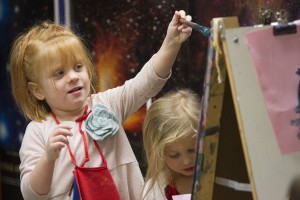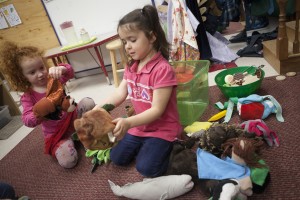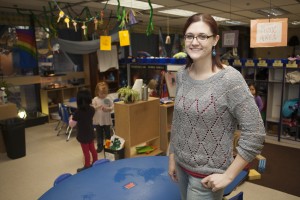Learning from the smallest kids on campus
by Jamie Gonzales |

Young artists at work, Tanaina Child Development Center. (Photo by Philip Hall/University of Alaska Anchorage)
You already know that UAA is a hot destination for graduate-degree-seeking engineers and nurses of all ages. You may not know that the Anchorage campus is also home base for some new, fresh-faced learners-kids who, if you ask them, tell you with certainty that one day they'll be Spider Man or Princess Elsa. It's okay, though, most of these students are under the age of six, when it's still cool to major in fantasy characters. And these mini learners have a lot to teach UAA's College of Education students and faculty.
Tanaina Child Development Center has been a campus fixture since 1979, when it was established to provide care for toddlers and preschoolers whose moms and dads were going to school. Now they serve between 60 and 65 children of faculty, staff and alumni, as well as students. They also serve as a community partner and research site for students and faculty from UAA's College of Education.
"The idea is that we'll become the model child development center for the state of Alaska," said Tanaina's director, Stefanie O'Brien. "We're in a good position to do that because we're here on an education campus. We have people studying the field as a resource at our fingertips." With assistance from the College of Education and thread, Tanaina is working toward accreditation and is on deck as a pilot center in the State of Alaska's new childcare facilities ratings program.
Though they "live" on campus in the Wells Fargo Sports Complex, Tanaina remains a private, non-profit partner with UAA. The university covers the cost of their physical space in exchange for first dibs on toddler and preschooler placements for UAA students, faculty, staff and alumni.
Partnering with UAA
"Our college has partnered with Tanaina for a long time," said Hilary Seitz, associate dean for the College of Education. Students studying early childhood education have been able to work with Tanaina teachers to complete their practicum hours from a variety of classes, she explained. Art and Creativity students, for example, lead small group arts activities for preschoolers.
Just like nursing students must rack up hours in medical clinics and doing hospital rotations, education students need to complete a number of observation and practicum hours in the field at child development centers and in Anchorage School District schools, watching master teachers in action, leading their own lessons and observing individual kiddos to track development.
Irene Bortnick, an adjunct professor for the College of Education, has students from her class observing in Tanaina's two toddler classes right now. Her students, she said, are connecting theory and philosophy with reality. "By concentrating on one child over a period of time, even though only a few weeks, they are able to see growth and changes and their observation skills improve. Their case study, which is the final product, will be shared with the parents as a thank you."

Free play in the morning lets kids use their imaginations at Tanaina Child Development Center. (Photo by Philip Hall/University of Alaska Anchorage)
"Having children nearby is really helpful," Seitz said. "Some of our students don't have transportation, so having that access is really valuable. We've had students who have kids over there, so there's that close connection. We have gone over there to help with professional development. Some faculty have done research projects over there, myself included. That's a huge benefit."
For several years, Seitz has studied early literacy, including research that recently paired 2nd and 3rd grade students from Polaris K-12 School with Tanaina preschoolers in a sort of "buddy reading" mentorship project. "I observed and took notes and did a lot of work with 2nd and 3rd grade students in the classroom, looking at their fluency and some of their literacy types of behaviors. Some of them showed huge gains-confidence really-in their reading," she said. The results of her study were published in a national journal earlier this year.
College of Education faculty have been a consistent presence on Tanaina's board of directors as well, said Seitz. They are currently helping to advise Tanaina as they work toward accreditation, according to O'Brien.
How many "whys" can you handle?

Kasey Michell, a Tanaina teacher and full-time College of Education student. (Photo by Philip Hall/University of Alaska Anchorage)
Kasey Michell, a full-time early childhood education major at UAA, works full-time at Tanaina as a co-lead teacher for one of the three preschool classes.
"It's busy, but I love it," she said. She's been teaching at Tanaina for a year and before that, worked as an assistant teacher at Head Start. Her favorite days in the classroom involve science lessons.
"If you ask the kids in my class where their patellas are, they can tell you where their patellas are," she said. "A good day is when we're able to do a really in-depth experiment where they are all engaged and actively learning." She recently blew young minds with some erupting volcano experiments. Three-, four- and five-year-olds are in their peak curiosity years, so they're eager to learn the how and why of everything. So, just how many "whys" in a row can Teacher Kasey handle from her curious charges?
"About four or five, I think," she said with a laugh. "Then I start asking them questions. Why do you think that? And see what they say."
One benefit of teaching full-time at Tanaina for Michell-beyond the hugs, of course-has been working some of her observation hours for school into her work schedule, learning from her little ones almost as much as they learn from her.
Seitz is enthusiastic about the College of Education's partnerships with Tanaina. She sees a lot of potential in their joint future. With the right support, UAA might one day be able to create a "lab school" or professional development school for early childhood educators.
Written by Jamie Gonzales, UAA Office of University Advancement
 "Learning from the smallest kids on campus" is licensed under a Creative Commons Attribution-NonCommercial 4.0 International License.
"Learning from the smallest kids on campus" is licensed under a Creative Commons Attribution-NonCommercial 4.0 International License.














